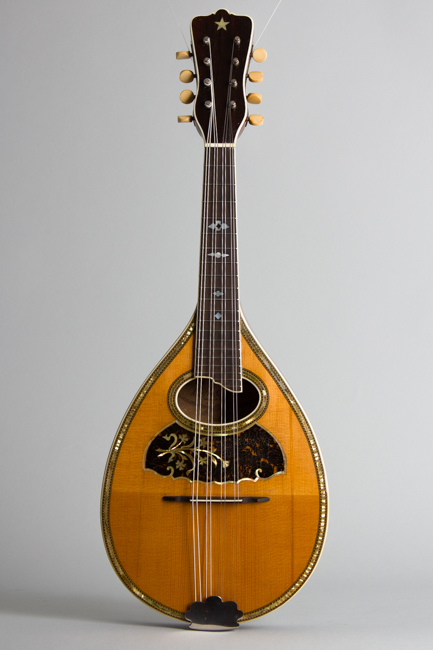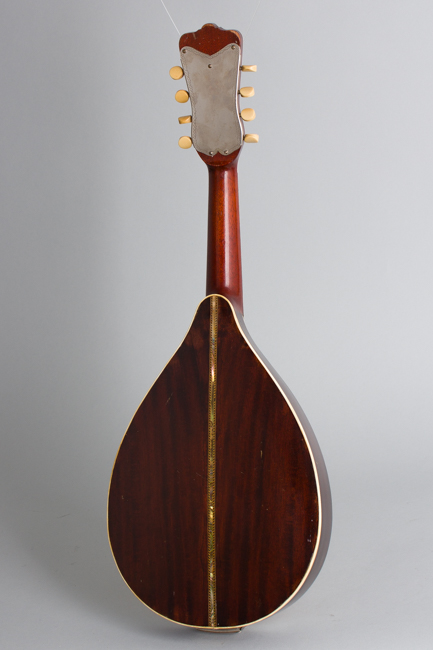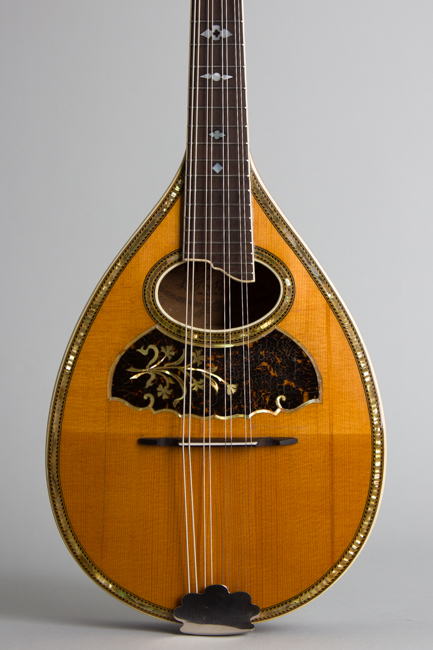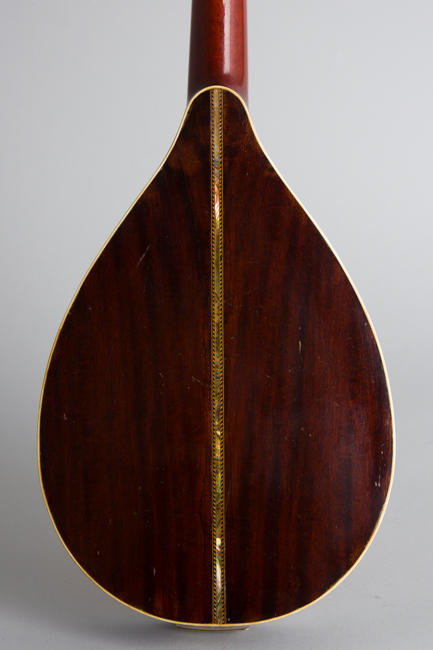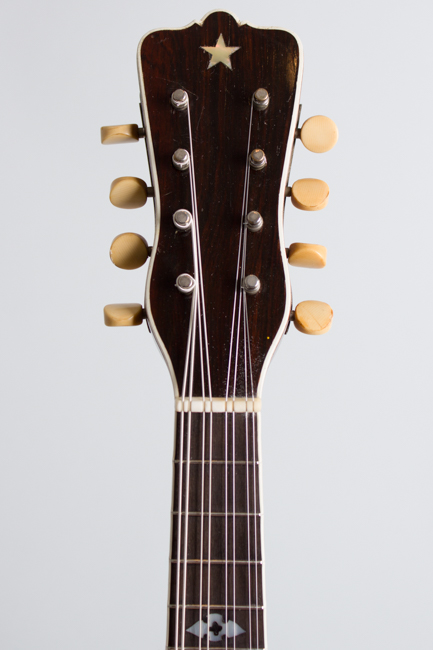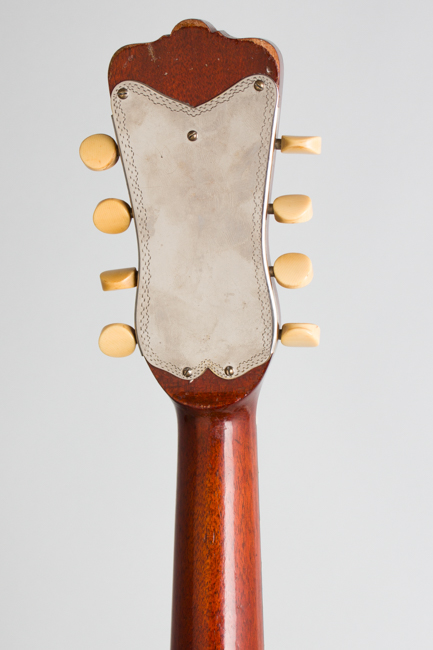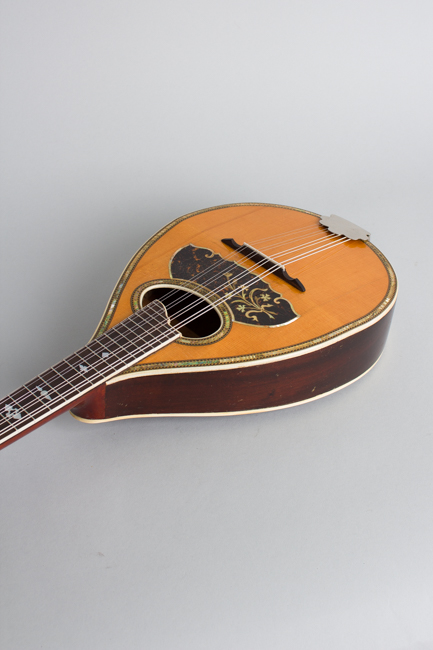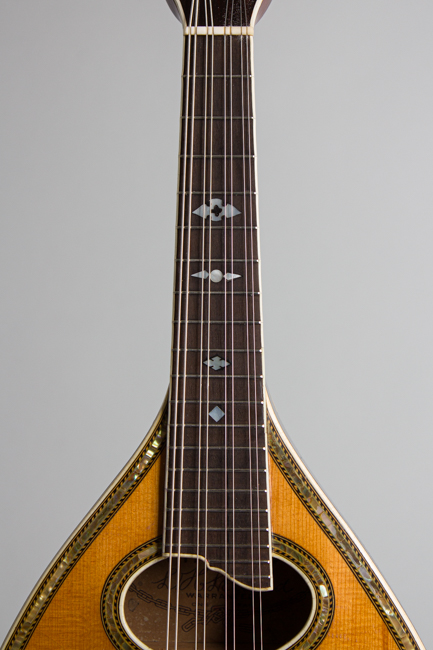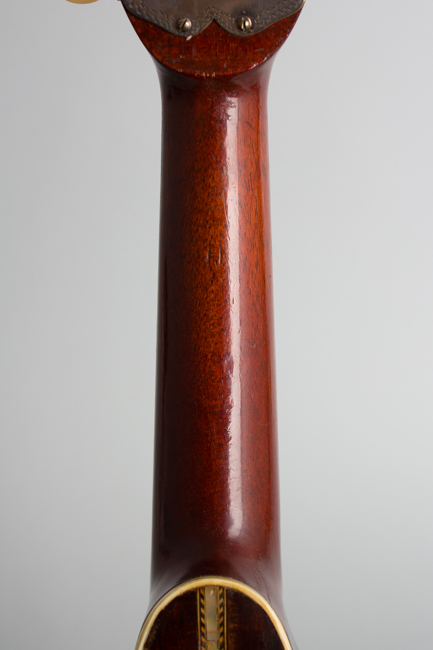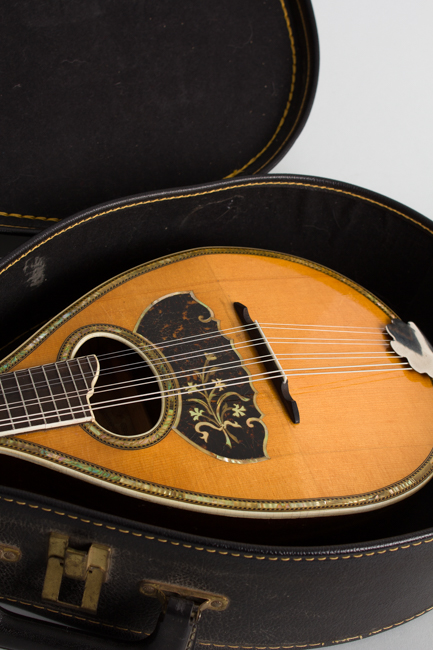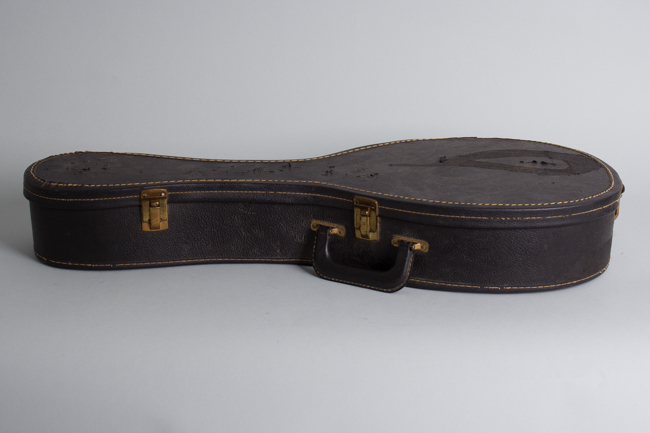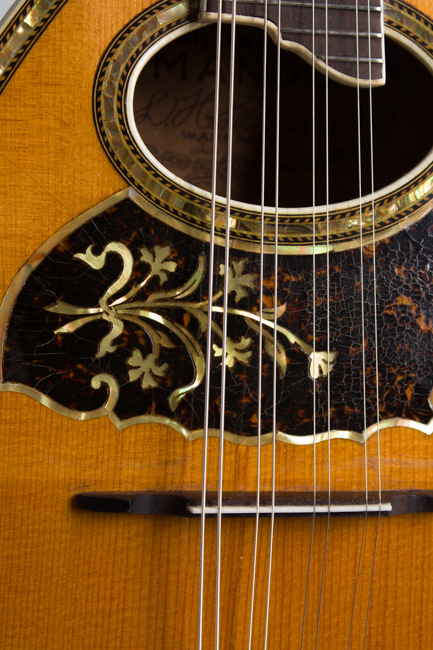Leland Brilliantone Flat Back, Bent Top Mandolin, most likely made by Harmony , c. 1918
This item has been sold.
Item # 12071
Prices subject to change without notice.
Leland Brilliantone Model Flat Back, Bent Top Mandolin, most likely made by Harmony, c. 1918, made in Chicago, serial # 10283, natural top, faux grained back and sides finish, black chipboard case.
The Leland name was initially associated with mandolins in the 1910s via Lyon & Healy, who cataloged an entire line of "L.H. Leland Mandos" in the middle of the decade. These were unique, unusually thin-bodied instruments, designed to have a very brilliant tone to cut in an orchestra setting. They were very short lived, and not a lot of information has survived about them outside of the original catalog materials. This instrument is NOT one of those, at least some of which are believed to have been made by the Larson Brothers.
This instrument is labelled "Leland Brilliantone" on a label under the soundhole and is a very fancy example of a typical Chicago-made flat back mandolin from the 1910-20's, most likely a product of the then-young Harmony company. It is all solid wood construction, with very elaborate cosmetics definitely a higher-end model. The body looks like rosewood, but much of that is due to a well executed faux finish on the sides and back. The top is spruce and the neck mahogany with an ebonized fingerboard.
Visually this is a beautiful instrument very artfully trimmed with celluloid on all edges with the top, soundhole and backstrip ornamented with lovely abalone and half-herringbone marquetry trim. The inlaid pickguard has a pearl floral pattern across the center and pearl bordering. The bound fingerboard has small shaped pearl inlay, while the headstock has a pearl star and bound edge with tuners inset from the back. This would have been an expensive instrument at the time, likely close to the top of the line.
Mandolins like this ARE very similar to instruments made by the Larson brothers in Chicago, and as such are often optimistically credited to them. While not really the artistic or playing equal of a genuine Larson, this is a quality instrument made of good woods in the early part of the century, a far cry from Harmony's later Depression-era output. The sound is more in the bowlback range but pleasant enough, and this is one of the nicest of this style of mandolin we have seen.
Overall length is 23 3/8 in. (59.4 cm.), 8 3/8 in. (21.3 cm.) across at the widest point, and 2 1/4 in. (5.7 cm.) in depth at side, taken at the end block. Scale length is 13 in. (330 mm.). Width of nut is 1 1/8 in. (29 mm.).
This is a nicely preserved instrument overall, showing some wear and repair but overall nicely preserved for something like 100+ years along. The original finish has some dents, dings and scratches but no really heavy wear. There are several old grain splits to the top and cracks to the back, all solidly and neatly sealed with some topical touchup. The instrument is quite solid, there is some dishing of the top in front of the soundhole (extremely common on this style of instrument) but the neck angle and bridge height are excellent. The frets have been crowned and the instrument is fully playable. While not the sonic equal of the Larson-made instruments it resembles, this is a good playing and quite attractive 1910s Chicago mandolin, a cool piece of fretted history. Overall Very Good + Condition.
The Leland name was initially associated with mandolins in the 1910s via Lyon & Healy, who cataloged an entire line of "L.H. Leland Mandos" in the middle of the decade. These were unique, unusually thin-bodied instruments, designed to have a very brilliant tone to cut in an orchestra setting. They were very short lived, and not a lot of information has survived about them outside of the original catalog materials. This instrument is NOT one of those, at least some of which are believed to have been made by the Larson Brothers.
This instrument is labelled "Leland Brilliantone" on a label under the soundhole and is a very fancy example of a typical Chicago-made flat back mandolin from the 1910-20's, most likely a product of the then-young Harmony company. It is all solid wood construction, with very elaborate cosmetics definitely a higher-end model. The body looks like rosewood, but much of that is due to a well executed faux finish on the sides and back. The top is spruce and the neck mahogany with an ebonized fingerboard.
Visually this is a beautiful instrument very artfully trimmed with celluloid on all edges with the top, soundhole and backstrip ornamented with lovely abalone and half-herringbone marquetry trim. The inlaid pickguard has a pearl floral pattern across the center and pearl bordering. The bound fingerboard has small shaped pearl inlay, while the headstock has a pearl star and bound edge with tuners inset from the back. This would have been an expensive instrument at the time, likely close to the top of the line.
Mandolins like this ARE very similar to instruments made by the Larson brothers in Chicago, and as such are often optimistically credited to them. While not really the artistic or playing equal of a genuine Larson, this is a quality instrument made of good woods in the early part of the century, a far cry from Harmony's later Depression-era output. The sound is more in the bowlback range but pleasant enough, and this is one of the nicest of this style of mandolin we have seen.
Overall length is 23 3/8 in. (59.4 cm.), 8 3/8 in. (21.3 cm.) across at the widest point, and 2 1/4 in. (5.7 cm.) in depth at side, taken at the end block. Scale length is 13 in. (330 mm.). Width of nut is 1 1/8 in. (29 mm.).
This is a nicely preserved instrument overall, showing some wear and repair but overall nicely preserved for something like 100+ years along. The original finish has some dents, dings and scratches but no really heavy wear. There are several old grain splits to the top and cracks to the back, all solidly and neatly sealed with some topical touchup. The instrument is quite solid, there is some dishing of the top in front of the soundhole (extremely common on this style of instrument) but the neck angle and bridge height are excellent. The frets have been crowned and the instrument is fully playable. While not the sonic equal of the Larson-made instruments it resembles, this is a good playing and quite attractive 1910s Chicago mandolin, a cool piece of fretted history. Overall Very Good + Condition.
